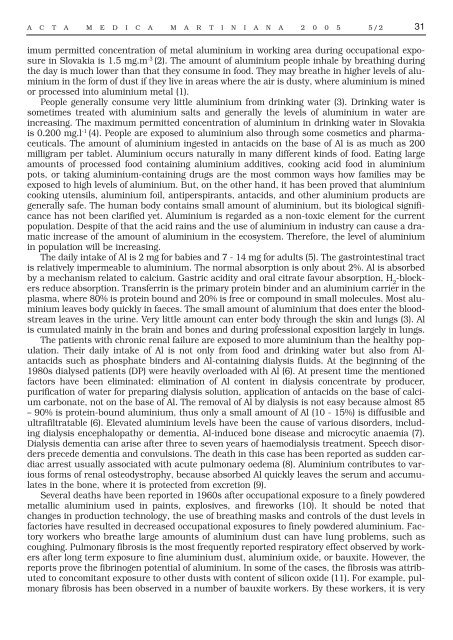MAKETA 5/2 po
MAKETA 5/2 po
MAKETA 5/2 po
You also want an ePaper? Increase the reach of your titles
YUMPU automatically turns print PDFs into web optimized ePapers that Google loves.
A C T A M E D I C A M A R T I N I A N A 2 0 0 5 5/2 31<br />
imum permitted concentration of metal aluminium in working area during occupational ex<strong>po</strong>sure<br />
in Slovakia is 1.5 mg.m -3 (2). The amount of aluminium people inhale by breathing during<br />
the day is much lower than that they consume in food. They may breathe in higher levels of aluminium<br />
in the form of dust if they live in areas where the air is dusty, where aluminium is mined<br />
or processed into aluminium metal (1).<br />
People generally consume very little aluminium from drinking water (3). Drinking water is<br />
sometimes treated with aluminium salts and generally the levels of aluminium in water are<br />
increasing. The maximum permitted concentration of aluminium in drinking water in Slovakia<br />
is 0.200 mg.l -1 (4). People are ex<strong>po</strong>sed to aluminium also through some cosmetics and pharmaceuticals.<br />
The amount of aluminium ingested in antacids on the base of Al is as much as 200<br />
milligram per tablet. Aluminium occurs naturally in many different kinds of food. Eating large<br />
amounts of processed food containing aluminium additives, cooking acid food in aluminium<br />
<strong>po</strong>ts, or taking aluminium-containing drugs are the most common ways how families may be<br />
ex<strong>po</strong>sed to high levels of aluminium. But, on the other hand, it has been proved that aluminium<br />
cooking utensils, aluminium foil, antiperspirants, antacids, and other aluminium products are<br />
generally safe. The human body contains small amount of aluminium, but its biological significance<br />
has not been clarified yet. Aluminium is regarded as a non-toxic element for the current<br />
<strong>po</strong>pulation. Despite of that the acid rains and the use of aluminium in industry can cause a dramatic<br />
increase of the amount of aluminium in the ecosystem. Therefore, the level of aluminium<br />
in <strong>po</strong>pulation will be increasing.<br />
The daily intake of Al is 2 mg for babies and 7 - 14 mg for adults (5). The gastrointestinal tract<br />
is relatively impermeable to aluminium. The normal absorption is only about 2%. Al is absorbed<br />
by a mechanism related to calcium. Gastric acidity and oral citrate favour absorption, H 2<br />
-blockers<br />
reduce absorption. Transferrin is the primary protein binder and an aluminium carrier in the<br />
plasma, where 80% is protein bound and 20% is free or com<strong>po</strong>und in small molecules. Most aluminium<br />
leaves body quickly in faeces. The small amount of aluminium that does enter the bloodstream<br />
leaves in the urine. Very little amount can enter body through the skin and lungs (3). Al<br />
is cumulated mainly in the brain and bones and during professional ex<strong>po</strong>sition largely in lungs.<br />
The patients with chronic renal failure are ex<strong>po</strong>sed to more aluminium than the healthy <strong>po</strong>pulation.<br />
Their daily intake of Al is not only from food and drinking water but also from Alantacids<br />
such as phosphate binders and Al-containing dialysis fluids. At the beginning of the<br />
1980s dialysed patients (DP) were heavily overloaded with Al (6). At present time the mentioned<br />
factors have been eliminated: elimination of Al content in dialysis concentrate by producer,<br />
purification of water for preparing dialysis solution, application of antacids on the base of calcium<br />
carbonate, not on the base of Al. The removal of Al by dialysis is not easy because almost 85<br />
– 90% is protein-bound aluminium, thus only a small amount of Al (10 - 15%) is diffusible and<br />
ultrafiltratable (6). Elevated aluminium levels have been the cause of various disorders, including<br />
dialysis encephalopathy or dementia, Al-induced bone disease and microcytic anaemia (7).<br />
Dialysis dementia can arise after three to seven years of haemodialysis treatment. Speech disorders<br />
precede dementia and convulsions. The death in this case has been re<strong>po</strong>rted as sudden cardiac<br />
arrest usually associated with acute pulmonary oedema (8). Aluminium contributes to various<br />
forms of renal osteodystrophy, because absorbed Al quickly leaves the serum and accumulates<br />
in the bone, where it is protected from excretion (9).<br />
Several deaths have been re<strong>po</strong>rted in 1960s after occupational ex<strong>po</strong>sure to a finely <strong>po</strong>wdered<br />
metallic aluminium used in paints, explosives, and fireworks (10). It should be noted that<br />
changes in production technology, the use of breathing masks and controls of the dust levels in<br />
factories have resulted in decreased occupational ex<strong>po</strong>sures to finely <strong>po</strong>wdered aluminium. Factory<br />
workers who breathe large amounts of aluminium dust can have lung problems, such as<br />
coughing. Pulmonary fibrosis is the most frequently re<strong>po</strong>rted respiratory effect observed by workers<br />
after long term ex<strong>po</strong>sure to fine aluminium dust, aluminium oxide, or bauxite. However, the<br />
re<strong>po</strong>rts prove the fibrinogen <strong>po</strong>tential of aluminium. In some of the cases, the fibrosis was attributed<br />
to concomitant ex<strong>po</strong>sure to other dusts with content of silicon oxide (11). For example, pulmonary<br />
fibrosis has been observed in a number of bauxite workers. By these workers, it is very

















